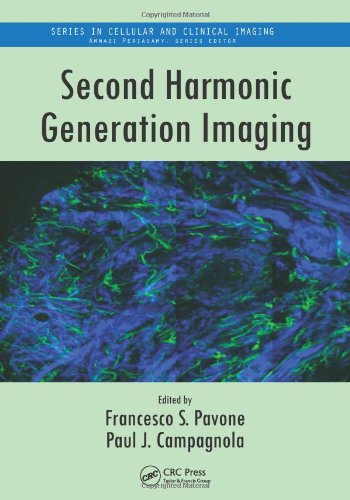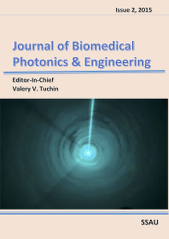A pulsed photoacoustic technique for studying red blood cell sedimentation
- Authors: Kinnunen M.1
-
Affiliations:
- Optoelectronics and Measurement Techniques Laboratory, University of Oulu, Finland
- Issue: Vol 1, No 1 (2015)
- Pages: 81-89
- Section: Articles
- URL: https://jbpe.ssau.ru/index.php/JBPE/article/view/1990
- ID: 1990
Cite item
Full Text
Abstract
This study shows the capability of a pulsed photoacoustic (PA) technique to measure red blood cell sedimentation and aggregation processes in vitro. Red blood cells are the main source of absorption in blood. The PA signal is proportional to the sample’s optical absorption coefficient, and hence, dynamic changes in the sample can be monitored by analyzing the PA pulse amplitude and pulse arrival time. Optical coherence tomography (OCT) is used as a parallel method for comparison. Diluted whole blood and different concentrations of washed red blood cells were used as samples. The pulsed PA technique is suitable for monitoring changes in sedimentation velocity when dextran is added to the sample. When the measurement section with the fastest sedimentation rate was selected for analysis, a more than 10-fold increase in the sedimentation rate, induced by dextran, was found with both the PA and OCT techniques. The PA pulse delay was found to be a more reliable measure of changes in the sample than the PA signal amplitude.
About the authors
Matti Kinnunen
Optoelectronics and Measurement Techniques Laboratory, University of Oulu, Finland
Author for correspondence.
Email: matti.kinnunen@ee.oulu.fi
Finland
References
- S. E. Bedell, and B. T. Bush, “Erythrocyte sedimentation rate. From folklore to facts,” Am. J. Med. 78, 1001-1009 (1985).
- T. L. Fabry, “Mechanism of erythrocyte aggregation and sedimentation,” Blood 70(5), 1572-1576 (1987).
- A. V. Priezzhev, N. F. Nikolai, and J. Lademann, “Light backscattering diagnostics of red blood cell aggregation in whole blood samples,” Handbook of optical biomedical diagnostics, Tuchin V. V. Ed., SPIE Press, Bellingham (2002).
- B. Neu, R. Wendy, and H. J. Meiselman, “Effects of dextran molecular weight on red blood cell aggregation,” Biophys. J. 95, 3059-3065 (2008).
- A. Westergren, “Studies of the Suspension Stability of the Blood in Pulmonary Tuberculosis,” Acta Medica Scandinavica 54, 247–282 (1921).
- L. E. Böttiger, and C. A. Svedberg, “Normal erythrocyte sedimentation rate and age,” Brit. Med. J. 2, 85-87 (1967).
- M. L. Bridgen, “Clinical utility of the erythrocyte sedimentation rate,” Am. Fam. Physician 60(5), 1443-1450 (1999).
- J. M. Jou, S. M. Lewis, C. Briggs, S.-H. Lee, B. de la Salle, and S. McFadden, “ICSH review of the measurement of the erythrocyte sedimentation rate,” Int. Jnl. Lab. Hem. 33, 125-132 (2011).
- A. V. Priezzhev, O. M. Ryaboshapka, N. N. Firsov, and I. V. Sirko, “Aggregation and disaggregation of erythrocytes in whole blood: study by backscattering technique,” J. Biomed. Opt. 4(1), 76-84 (1999).
- C. V. L. Pop, and S. Neamtu, “Aggregation of red blood cells in suspension: study by light-scattering technique at small angles,” J. Biomed. Opt. 13(4), 041308 (2008).
- X. Xu, L. Yu, and Z. Chen, “Velocity variation assessment of red blood cell aggregation with spectral domain Doppler optical coherence tomography,” Ann. Biomed. Eng. 38, 3210-3217 (2010).
- F. T. H. Yu, and G. Cloutier, “Experimental ultrasound characterization of red blood cell aggregation using the structure factor size estimator (SFSE),” J. Acoust. Soc. Am. 122, 645-656 (2007).
- E. Franceschini, F. T. H. Yu, F. Destrempes, and G. Cloutier, “Ultrasound characterization of red blood cell aggregation with interventing attenuation tissue mimicking phantoms using structure factor size and attenuation estimator,” J. Acoustic Soc. Am. 127, 1104-1115 (2010).
- S. J. Lee, H. Ha, and K.-H. Nam, “Measurement of red blood cell aggregation using X-ray phase contrast imaging,” Opt. Express 18, 26052-26061 (2010).
- Z. Zhao, X. Wang, and J. F. Stoltz, “Comparision of three optical methods to study erythrocyte aggregation,” Clinical Hemorheology and Microcirculation 21, 297-302 (1999).
- M. R. Hardeman, J. G. G. Dobbe, and C. Ince, “The laser-assisted optical rotational cell analyzer (LORCA) as red blood cell aggregometer,” Clinical Hemorheology and Microcirculation 25, 1-11 (2001).
- I. Y. Kuo, and K. K. Shung, “High frequency ultrasonic baskscatter from erythrocyte suspension,” IEEE Trans. Biomed. Eng. 41(1), 29-34 (1994).
- M. S. van der Heiden, M. G. M. de Kroon, N. Bom, and C. Borst, “Ultrasound backscatter at 30 MHz from human blood: influence of rouleau size affected by blood modification and shear rate,” Ultrasound in Med. & Biol. 21(6), 817-826 (1995).
- A. A. Oraevsky, S. L. Jacques, F. K. Tittel, “Measurement of tissue optical properties by time-resolved detection of laser-induced transient stress,” Appl. Opt. 36, 402-415 (1997).
- J. S. Antoniow, J. Egèe, M. Chirtoc, C. Bissieux, and G. Potron, “Real time analysis of erythrocyte sedimentation by photothermal methods,” Journal de Physique IV, CT-469 – C7-472 (1994).
- A. Landa, and J. J. Alvarado-Gil, “Photoacoustic monitoring of real time blood and hemolymph sedimentation,” Rev. Sci. Instrum. 74(1), 377-379 (2003).
- P. Helander, and I. Lundström, “Whole blood – a sedimenting sample studied by photoacoustic spectroscopy,” J. Photoacoust. 1(2), 203-215 (1982).
- S. Oka, “A physical theory of erythrocyte sedimentation,” Biorheology 22, 315-321 (1985).
- E. I. Galanzha, and V. P. Zharov, “In vivo photoacoustic and photothermal cytometry for monitoring multiple blood rheology parameters,” Cytometry Part A 79 A, 746-757 (2011).
- H. Schmid-Schönbein, H. Malotta, and F. Striesow, “Erythrocyte aggregation: causes, consequence and methods of assessment”, J. Netherlands Soc. Clin. Chem. 15, 88-97 (1990).
- J. K. Armstrong, R. B. Wendy, H. J. Meiselman, and T. C. Fisher, “The hydrodynamic radii of macromolecules and their effect on red blood cell aggregation,” Biophys. J. 87, 4259-4270 (2004).
- X. Xu, R. K. Wang, J. B. Elder, and V. V. Tuchin, “Effect of dextran-induced changes in refractive index and aggregation on optical properties of whole blood,” Phys. Med. Biol. 48, 1205-1221 (2003).
- V. V. Tuchin, X. Xu, and R. K. Wang, “Dynamic optical coherence tomography in studies of optical clearing, sedimentation, and aggregation of immersed blood,” Appl. Opt. 41(1), 258-271 (2002).
- V. V. Tuchin, R. K. Wang, E. I. Galanzha, J. B. Elder, and D. M. Zhestkov, “Monitoring of glycated hemoglobin by OCT measurements of refractive index,” Proc. SPIE 5316, 66-77 (2004).
- X. Xu, V. V. Tuchin, and R. K. Wang, “Immersion technique as a tool for in depth OCT imaging trough human blood and body’s interior tissues,” Proc. SPIE 4251, 89-96 (2001).
- V. V. Tuchin, R. K. Wang, and X. Xu, “Whole blood and RBC sedimentation and aggregation study using OCT,” Proc. SPIE 4263, 143-149 (2001).
- X. Xu, L. Yu, and Z. Chen, “Effect of erythrocyte aggregation on hematocrit measurement using spectral-domain optical coherence tomography,” IEEE Trans. Biomed. Eng. 55(12) 2753-2758 (2008).
- V. V. Tuchin, Optical clearing of tissues and blood, SPIE press, Washington, Bellingham, USA, 2006.
- M. Yu Kirillin, A. V. Priezzhev, V. V. Tuchin, R. K. Wang, and R. Myllylä, “Effect of red blood cell aggregation and sedimentation on optical coherence tomography signals from blood samples,” J. Phys. D: Appl. Phys. 38, 2582-2589 (2005).
- V. V. Tuchin, D. M. Zhestkov, A. N. Bashkatov, and E. A. Genina, “Theoretical study of immersion optical clearing of blood in vessels at local hemolysis,” Opt. Express 12(13), 2966-2971 (2004).
- C. Li, and L. V. Wang, “Photoacoustic tomography and sensing in biomedicine,” Phys. Med. Biol. 54, R59-R97 (2009).
- J. Laufer, C. Elwell, D. Delpy, and P. Beard, “In vitro measurements of absolute blood oxygen saturation using pulsed near-infrared photoacoustic spectroscopy: accuracy and resolution,” Phys. Med. Biol. 50, 4409-4428 (2005).
- J. Laufer, D. Delpy, C.Elwell, and P. Beard, “Quantitative spatially resolved measurement of tissue chromophore concentrations using photoacoustic spectroscopy: application to the measurement of blood oxygenation and haemoglobin concentration,” Phys. Med. Biol. 52, 141-168 (2007).
- R. K. Saha, and M. C. Kolios, “A simulation study on photoacoustic signals from red blood cells,” J. Acoust. Soc. Am. 129(5), 2935-2943 (2011).
- E. Hysi, R. K. Saha and M. C. Kolios, "On the potential of using photoacoustic spectroscopy to monitor red blood cell aggregation", Proc. SPIE 8222, 82220Q (2012)
- G. Barshtein, I. Tamir, and S. Yedgar, “Red blood cell rouleaux formation in dextran solution: dependence on polymer conformation,” Eur. Biophys. J. 27, 177-181 (1998).
- M. Kinnunen, and R. Myllylä, ”Application of Optical Coherence Tomography, Pulsed Photoacoustic Technique and Time-of-flight Technique to Detect Changes in the Scattering Properties of a Tissue-simulating Phantom,” J. Biomed. Opt. 13(2), 024005-(1-9) 2008.
- G. J. Diebold, and T. Sun, “Properties of photoacoustic waves in one, two, and three dimensions,” Acustica 80, 339-351 (1994).
- M. Kinnunen, "Monitoring the effect of dextran on blood sedimentation using a pulsed photoacoustic technique", Proc. SPIE 8222, 82221E (2012).
- F. A. Duck, Physical properties of tissue: a comprehensive reference book, Academic Press Inc., San Diego (1990).
- M. Meinke, G. Müller, J. Helfmann, and M. Friebel, “Optical properties of platelets and blood plasma and their influence on the optical behavior of whole blood in the visible to near infrared wavelength range,” J. Biomed. Opt. 12(1), 014024 (2007).
- A. B. Karpiouk, S. R. Aglyamov, S. Mallidi, J. Shah, W. G. Scott, J. M. Rubin, and S. Y. Emelianov, “Combined ultrasound and photoacoustic imaging to detect and stage deep vein thrombosis: phantom and ex vivo studies, “ J. Biomed. Opt. 13(5), 054061 (2008).
- R. D. Eastham, “The erythrocyte sedimentation rate and the plasma viscosity,” J. Clin. Path. 7, 164-167 (1954).
- S. Kim, S. Yang, and D. Lim, “Effect of dextran on rheological properties of rat blood,” Journal of Mechanical Science and Technology, 23, 868-873 (2009).
- M. Kinnunen, Z. Zhao, and R. Myllylä, ”Glucose-induced changes in the optical properties of Intralipid,” Optics and Spectroscopy, 101(1), 54-59 (2006).
- B. E. Treeby, E. Z. Zhang, A. S. Thomas, and B. T. Cox, “Measurement of the ultrasound attenuation and dispersion in whole human blood and its components from 0-70 MHz,” Ultrasound in Med. & Biol. 37(2), 289-300 (2011).
- H.-J. Lim, Y.-J. Lee, J.-H. Nam, S. Chung, and S. Shin, “Temperature-dependent threshold shear stress of red blood cell aggregation,” Journal of Biomechanics, 43, 546-550 (2010).
- D. J. Faber, F. J. van der Meer, M. C. G. Aalders, and T. G. van Leeuwen, “Quantitative measurement of attenuation coefficients of weakly scattering media using optical coherence tomography,” Opt. Express 12(19), 4353-4365 (2004).
- Z. Zhao, S. Nissilä, O. Ahola, and R. Myllylä, ”Production and detection theory of pulsed photoacoustic wave with maximum amplitude and minimum distortion in absorbing liquid,” IEEE Transaction on Instrumentation and Measurement, 47(2), 578-583 (1998).
Supplementary files







